Matcha Cake

Matcha is the soul of matcha cake. If you want to make good matcha cake, you have to use good quality matcha.
Matcha powder has three enemies: heat, light and oxygen. The colour and flavour deteriorate very quickly unless the tea is kept in the cold, in the dark, away from oxygen.
Good matcha is sold in an airtight and lightproof metal container, and it comes with an oxygen absorber. It should be used as soon and as quickly as possible. And it should be refrigerated, even when it’s still sealed.
Lousy matcha, OTOH, sits in a see-through plastic container that’s sealed but not really airtight. It’s essentially hay with artificial colouring and flavouring. It’s good if you’re baking a cake for your pet rabbit.
To make green tea cake, just take whatever cake recipe you like and substitute a bit of the flour with matcha. Right?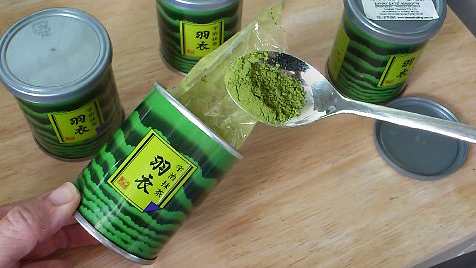
Yes, of course you can do that. In fact, a lot of people do. But matcha and wheat flour are two entirely different things. The former consists of fibrous leaves. The latter consists of protein and starch.
Compared to flour, ground up leaves absorb more water but less fat. Unless you adjust the recipe, a cake made with green tea powder would be less fluffy and more oily than one made without.
Besides the absorbency, there’re two more differences between matcha and flour.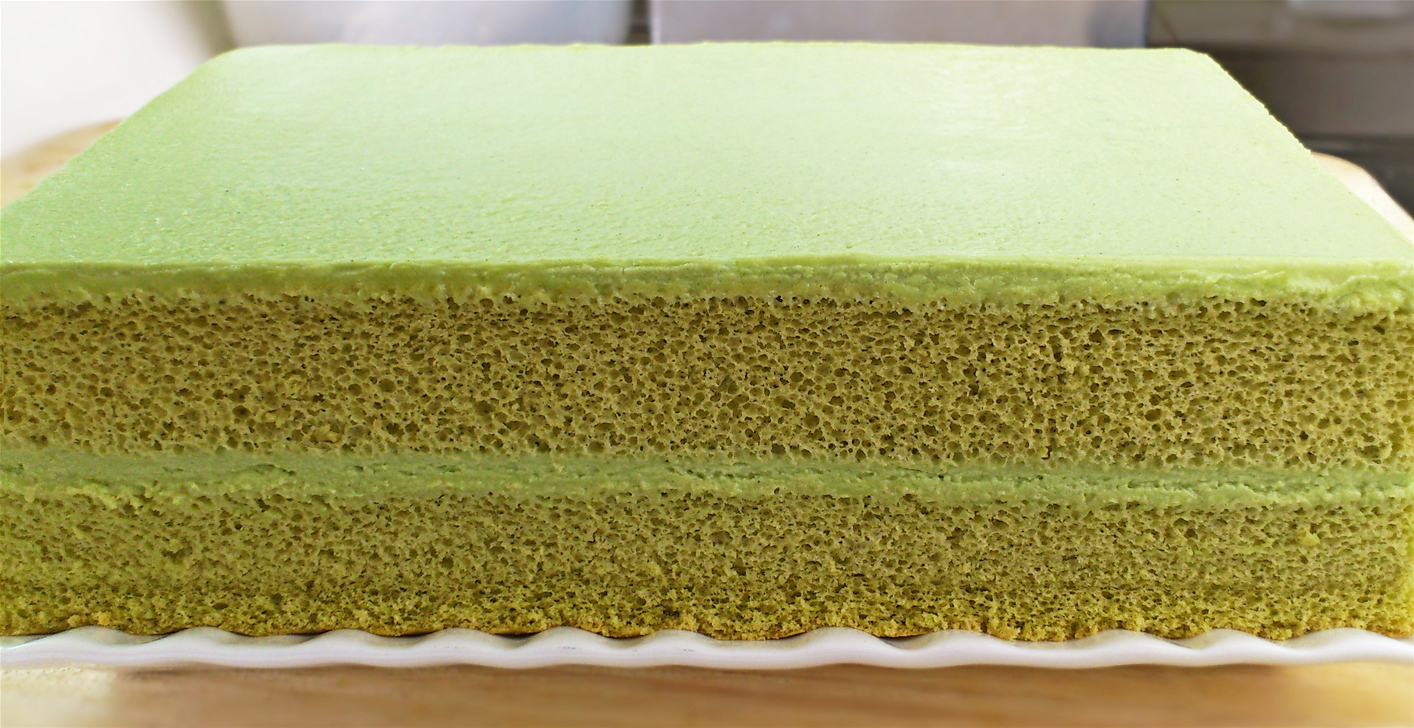
Does matcha taste like flour? Of course it doesn’t. Green tea powder is slightly bitter but flour isn’t. It makes the cake less sweet.
Does matcha brown like flour? Nope, it doesn’t. Wet leaves don’t brown, so green tea powder makes the cake brown slower unless you add more sugar or increase the oven temperature.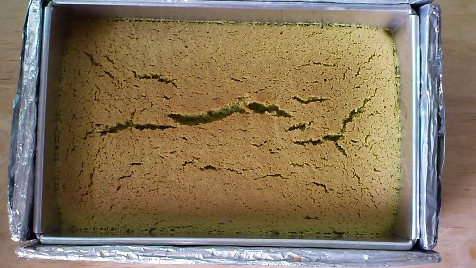
Most cake recipes need a wee bit of salt. You shouldn’t be able to taste the salt at all. It’s there to round off the sweetness. Green tea cake, however, doesn’t need any salt because matcha does the “rounding off”. If there’s salt, you’d be able to taste it.
The flavour of green tea powder is very delicate. If there’s baking soda/powder in the recipe, the delicate flavour would be compromised. Hence, green tea cake should be made without any baking soda/powder.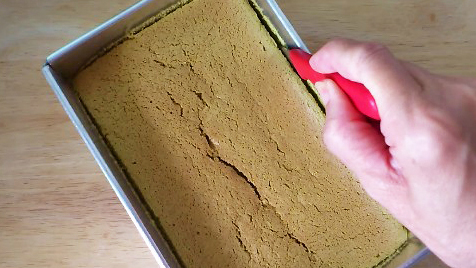
I don’t like green tea cake that’s dense, salty, oily, not sweet, not brown and not “matcha-ish”. Do you?
My green tea cake is made with a recipe that’s dedicated to making green tea cake that’s soft, fluffy, and subtly fragrant with the scent of green tea powder. It’s not some vanilla cake with the vanilla yanked out and matcha bunged in.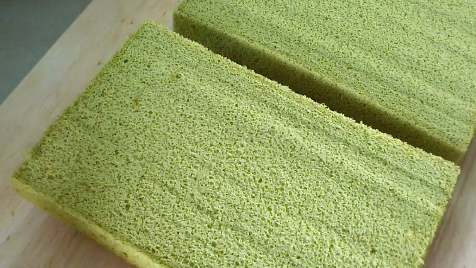
If you want to try my recipe, be warned that the cake cracks even with cardboard insulation to help it rise evenly. The cracks close up nicely as the cake cools down but you’d still see a few lines. Here’s what the cake looks like hot from the oven and after cooling down:
After baking my way through four bottles of GTP, I’m now happy with my recipe. I hope you like it too.
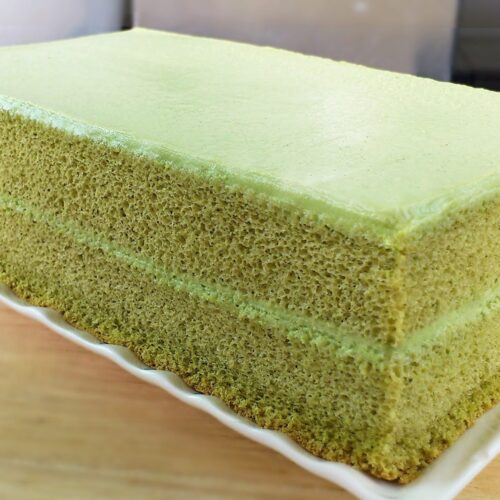
Matcha Cake
Video
Ingredients
Cake
- 10 g castor sugar
- 60 g egg yolks
- 30 g corn oil
- 20 g boiling water
- 5 g green tea powder
- 30 g room temperature water
- 40 g cake flour
- 105 g egg whites
- 1/16 tsp cream of tartar
- 45 g castor sugar
Whipped cream
- 200 g dairy cream ≈35% fat, thoroughly chilled
- 1 tsp green tea powder
Instructions
- To make cake, trim 5 mm thick corrugated cardboard to fit sides of 23 x 15 cm cake pan. Wrap each piece of cardboard in aluminium foil, shining side facing out. Line bottom of 20 x 12 x 7.5 cm cake pan with 2 layers of parchment paper.
- Preheat oven to 160°C. Measure ingredients for cake and prepare green tea as detailed above.
- Add 20 g boiling water to green tea powder. Mix till smooth. Add 30 g room temperature water, mix thoroughly, set aside to cool down20 g boiling water, 5 g green tea powder, 30 g room temperature water
- Whisk 10 g castor sugar with egg yolks till dissolved. Add corn oil. Whisk till just combined. Add green tea. Whisk will just thoroughly mixed. Sift cake flour into mixture. Whisk till just thoroughly mixed but small lumps are still visible.10 g castor sugar, 60 g egg yolks, 30 g corn oil, 40 g cake flour
- Separately whisk egg whites till frothy. Add cream of tartar. Whisk till thick foam forms. Gradually add 45 g castor sugar whilst still whisking. Continue to whisk till firm peak stage.105 g egg whites, 1/16 tsp cream of tartar, 45 g castor sugar
- Thoroughly whisk yolk mixture, which should be smooth now. Add half of egg whites. Mix with whisk till almost even. Add remaining egg whites. Mix with whisk till almost even. Scrape down and fold with spatula till just evenly mixed, banging mixing bowl against worktop 2-3 times.
- Pour batter into 20 x 12 x 7.5 cm cake pan, slowly and from about 30 cm high. Jiggle pan till batter is level.
- Place cake pan holding batter in 23 x 15 cm cake pan. Tuck cardboard between 2 pans. Bake till middle of cake doesn’t make squishing sound when pressed gently, about 55 minutes.
- Remove pans from oven. Remove cardboard and outer pan. Drop pan holding cake from about 30 cm high, 2-3 times. Invert pan onto wire rack. Leave till just cool.
- As soon as cake is cool, slide knife along sides of pan. Unmould cake. Discard both layers of parchment paper.
- To make whipped cream, whisk cream till just thick enough to hold its shape. Add green tea powder. Whisk till evenly mixed and cream is dead stiff.200 g dairy cream, 1 tsp green tea powder
- To assemble, cut cake horizontally with serrated knife or cake slicer into 2 equal halves. Set aside bottom half of cake. Invert top half so that cut side faces up. Spread with half of whipped cream. Top with remaining half of cake, cut side down. Spread with remaining whipped cream. Smooth top. Trim about 1 cm from 4 edges.
- Transfer cake to serving plate. Refrigerate till ready to serve. Enjoy trimmings whilst waiting.